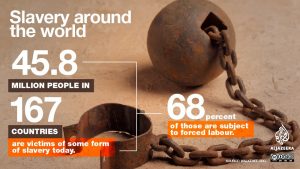1. Racial Capitalism and Colonialism
Slavery and Indenturement Today
As the narrator mentions at the end of the video, “there are still millions working in conditions of slavery and indenturement today. It’s a reality that is often hidden from and denied by mainstream society.” (Video 1: Racial Capitalism and Colonialism, 8:53)
Conditions of slavery and indenturement refers to those who are in situations of exploitation in which a person cannot refuse or leave because of threats, violence, coercion, deception, or abuse of power (Walk Free). Human trafficking and forced labour (see Figure 1.2 below) are common practices around the world that predominantly affect Black and Brown working poor people.

While exploring resources and information on the topic of what some refer to as “modern day slavery”, it is important to identify how mainstream movements for anti-trafficking, for example, reproduce carceral logics of violence and punishment (key features of colonialism and capitalism). This topic is very complex, and when understood from a capitalist and colonial lens, the supposed solutions end up repeating the same patterns. For example, arresting individuals for perpetuating human trafficking, who are then sent to prison and enter into forced labour.
Human Trafficking
According to the United Nations, human trafficking is the recruitment, transportation, transfer, harbouring or receipt of people through force, fraud or deception, with the aim of exploiting them for profit.
For deeper dive into Human Trafficking in Canada, check out Jocelyn Davison’s talk for TEDxUAlberta found below called “People For Sale: Human Trafficking in Canada” (14 minutes). You can also explore APTN InFocus feature “Bringing attention to Canada’s secret shame: Human Trafficking” (1 hour).
Recommended Further Reading
- Trina Roache, “$150B global human trafficking industry happening in plain sight in Canada say experts,” APTN National News, April 16, 2021 (article)
- Blair Rhodes, “Canadians ‘shockingly unaware’ of human trafficking, says national organization,” CBC News, December 6, 2021 (article)
Forced Labour
According to the International Labour Organization (ILO), forced labour can be understood as work that is performed involuntarily and under the menace of any penalty. It refers to situations in which persons are coerced to work through the use of violence or intimidation, or by more subtle means such as manipulated debt, retention of identity papers or threats of denunciation to immigration authorities.
Some contemporary examples of forced labour today include the internment camps in Xinjuang China, bonded labour in Pakistan and child labour in the chocolate industry in Ghana and the Ivory Coast (see articles below).
It is quite common, particularly in Canada, to think that these types of experiences don’t happen here. Next we will highlight two specific examples that relate to the Canadian context as well: migrant and prison labour.
Recommended Further Reading
- Jewher Ilham, “There’s a good chance your cotton T-shirt was made with Uyghur slave labor,” The Guardian, April 9th, 2021 (article)
- Shahzeb Jillani, “Life of Slavery – the perpetuation of bonded labor in Pakistan,” DW, December 25th, 2019 (article)
- Oliver Balch, “Chocolate industry slammed for failure to crack down on child labour,” The Guardian, October 20th, 2020 (article)
Example: Prison Labour
Prison or penal labour is a type of forced labour that prisoners are required to perform. It is often manual labour and has been referred to as involuntary servitude (which we discussed in our introductory video), penal servitude and imprisonment with hard labour. It’s roots can be traced back to colonialism and enslavement and it continues to to play a large role in present day mass incarceration. The video below by NowThis World “Is Slave Labor Legal in America?” focuses on the U.S. context, while this is a relevant conversation here in Canada too. Check out Justin Ling’s exploration of Prison Labour for the Canadian Bar Association and explore the work of the Toronto Prisoner’s Rights Project.
https://www.youtube.com/watch?v=KtYMnavxaKc
Note that the video above appears supportive of the existence in prisons, while simply questioning the use of prison labour. Issues with the prison industry and practice of imprisonment goes beyond the specific topic of prison labour. (which includes prison abolition) will be explored further in the next section. In the meantime, check out the short clips below of both Angela Davis and Ruth Wilson Gilmore talking about prison abolition.
Recommend further reading
- Whitney Benns, “American Slavery, Reinvented,” The Atlantic, September 21, 2015 (article + video)
- Kevin Rashid Johnson, “Prison labor is modern slavery. I’ve been sent to solitary for speaking out,” The Guardian, August 23rd, 2018 (article)
Example: Migrant Labourers
For example, migrant labourers who are forced to travel internationally for work hold up the backbone of many Western economies. Yet they are treated as second-class citizens, in what is called a state of “unfreedom”. They have little access to health care and education in their host countries, earn much lower than the minimum wage and are forced to travel back and forth between their home countries and places of work for years on end with no pathway to citizenship in the country where they work. These workers are hidden away from mainstream societies, often not talked about, even though they do some of our most vital work like food production and raising our children.
For a deeper dive into the experience of migrant farm workers in Canada and the systemic oppression and exploitation they face and resist on an ongoing basis, check out Min Sook Lee’s film Migrant Dreams. The trailer is below, while you can access the full film here.
You can also check out episode 22 of the Henceforward podcast – Migrant Labour, White Settler Anxiety, and No Returns. In the podcast Nisha Toomey and Chris Ramsaroop explore the Seasonal Agricultural Worker Program in Canada.
To learn more about the experience of migrants in Canada explore local organizations further like No One is Illegal Toronto and the Migrant Rights Network who resist the unjust treatment of these members of our community.
Recommend further reading
- “Exploitation of migrant care workers has increased since COVID-19 struck, report says,” CBC, October 28, 2020 (article)
- Mary Baxter, “‘They all were labour abused’: Demanding action on the exploitation of migrant workers,” tvo, June 26, 2020 (article)
- Justice Beach, “The Similarities Between Canada’s Temporary Foreign Worker Program and Slavery,” Huffpost blog, April 17th, 2014 (article)
- Benjamin Harkis, “Wage theft: the missing middle in exploitation of migrant workers,” Open Democracy, January 21, 2021 (article)
 Music
Music
For a transcript of the lyrics for the song Borders visit Genius’s page for Borders.
For a transcript of the lyrics for the song Pa’lante visit Genius’s page for Pa’lante
 Reflection 9
Reflection 9
Enter your reflection journal and respond to the following questions:
- What are products and/or services that you use regularly in your life that may require forced labour (what some refer to as modern day slavery) or indenturement?
- If you are unsure, consider using the following tool: https://slaveryfootprint.org/
Note: to access your reflection journal please review the Introduction section of the Racial Capitalism and Colonialism module.
An ideology and ongoing practice that examines the root structures of violence, and seeks to create alternative systems beyond the ones that currently exist. Abolitionists, particularly prison abolitionists, understand that the structures of violence that shape our world are functioning the way they are supposed to (with the intention to cause violence and harm) thus such systems need to be dismantled and others need to be ushered in to create a more just world. In an interview, Mariame Kaba explains that part of her work as a prison abolitionist is to “think of how we can crowd out the current system by building the things that we want to see in the world, that will promote our well-being”.

